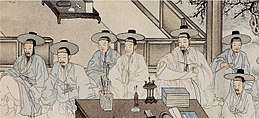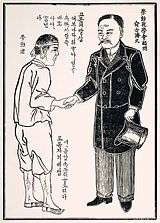Manhwa
Manhwa (Hangul: 만화, Hanja: 漫畵; Korean pronunciation: [manhwa]) is the general Korean term for comics and print cartoons (common usage also includes animated cartoons). Outside Korea, the term usually refers to South Korean comics,[1] although the comics industry is emerging in North Korea as well.[2]

| Comics |
|---|
| Comics studies |
| Methods |
| Media Formats |
| Comics by Country and Culture |
| Community |
|
|
 |
| Part of a series on the |
| Culture of Korea |
|---|
| History |
|
Festivals |
|
|
Music and performing arts |
|
Media
|
|
|
Monuments
|
|
National symbols of Korea
|
| Manhwa | |
| Hangul | |
|---|---|
| Hanja | |
| Revised Romanization | manhwa |
| McCune–Reischauer | manhwa |
History of the term

Linguistically, 漫画 (manga), 漫画 (manhua), and 만화 (漫畵 manhwa) all mean comics in Japanese, Chinese, and Korean respectively. The Korean term 만화 (漫畵 manhwa), along with the Japanese term 漫画 (manga), are cognates of the Chinese phrase manhua (literally:"impromptu sketches").[3] The current usage of the terms "manhwa" and "manhua" in English is largely explained by the international success of the Japanese manga. Although in a traditional sense, in these languages the terms manga/manhua/manhwa had a similar meaning of comical drawing in a broad way, in English the terms manhwa and manhua generally designate the manga-inspired comic strips.
The term manhwa came into popular use in Korea during the 1920s,[4] when it was applied to cartoons. Korea was under Japanese occupation from 1910 to 1945 and during this time elements of Japanese language and culture were incorporated into Korean society.[5] By the mid 1920s, most political newspapers were shut down,[6] and political and social cartoons were abandoned in favor of children’s and humorous illustrations.
Political cartoons slowly reemerged following the establishment of the Republic of Korea (commonly known as South Korea) in 1948.[7] During the early years of Japanese occupation, newspaper comics featured a great deal of social criticism. Popular artist Kim Yong-hwan started Korea’s first comic magazine, Manhwa Haengjin, in 1948,[8] but it was quickly shut down because the authorities disapproved of the cover.
The popularity of comics rose during the 1950s and 1960s,[9] and the diversity of styles and subject matter led to the creation of new genres such as sunjeong (or soonjung),[10] romantic stories aimed at young women (equivalent to the Japanese genre Shoujo). Manhwabang, comics cafés and stores that allowed readers to pay a set rate to sit and read comics, were also introduced to the public.[11] In response to the increasing publication of comics, as well as social and political changes within South Korea, the government began to enforce censorship laws and, by the mid-1960s, created a comics distribution monopoly that further censored manhwa.[12]
Manga influenced manhwa from the medium’s beginnings during the Japanese occupation of Korea and continued to exert a powerful influence as the manga industry became a major force within Japanese culture and began to export comics abroad. The author or artist of a manhwa is called a manhwaga (만화가, 漫畵家). Manhwaga were not culturally isolated, and the influx of manga into the Korean comics market had a strong effect on the art and content of many artists’ manhwa.[13]
Adaptation of term
The relative obscurity of Korean culture in the Western world has caused the word "manhwa" to remain somewhat unknown in the English-speaking world. English translations of manhwa have achieved success by targeting the manga and anime community, to the extent that manhwa were marketed as "manga" by the American publisher Tokyopop.
Webtoons
Webtoons first came into popularity in the early 2000s due to their free access and availability on the internet.[14] Since their creation, webtoons have gained popularity around the globe and have even been adopted outside of Korea as another form of comic publication.[15] This is credited to their unique format and pay model.
Korean manhwa publishers
Note: select publishers only
- Daewon C.I.
- Haksan Culture Company
- Seoul Culture Corporation
- Shinwon Agency Corporation
Manhwa in the United States
Sanho Kim was the first manhwa artist working in the States. During the 1960s and 70s, he worked for publishers Charlton Comics, Warren Publishing, Iron Horse Publishing, Skywald Publications and Marvel Comics.[16]
According to journalist Paul Gravett, in 1987 Eastern Comics published the first original manhwas in the United States.[17]
Due to the explosion of manga's popularity in the Americas, many of the licensed titles acquired for the American market seek to emulate the popular elements of other successful series.[18] Recently, long-running webtoons serialized via Internet portal sites (e.g. by Daum Media)[19], like Lehzin Comics[20], and personal homepages have become both the creative and popular destination among the younger generation in Korea. With manga proving to be both popular and commercially successful in Europe and the United States, a number of publishers imported and translated manhwa titles in the hope of reaching the same audience. The readability and left-to-right orientation of manhwa contributed to its growing popularity, as did the realism of the characters and the combination of Eastern and Western styles and mythologies. Popular manhwa in the U.S. and European markets include Ragnarok, Priest, Island, and Tarot Café.[21]
Direction of text
Manhwa is read in the same direction as English books, horizontally and from left to right, because hangul is normally written and read horizontally, although it can also be written and read vertically from right to left, top to bottom.
North American manhwa imprints
- ADV Manga
- Dark Horse Manhwa
- DramaQueen
- DrMaster Publications
- Media Blasters
- Netcomics
- NBM ComicsLit
- Seven Seas Entertainment
- SuperAni
- UDON's Korean Manhwa
- Yen Press
Popular Manhwas
Solo Leveling
Currently one of the most popular Manhwa to get mainstream attention is Solo Leveling, first written as a light novel by Chu-Gong on February 14, 2014. and adapted into a Manhwa later in 2019. The Light novel ended up with 14 volumes and 270 chapters. The webtoon is still ongoing with 110 chapters released in the first season. Season 2 of Solo Leveling is supposed to be released in 2021.
It is an Isekai manhwa where people get transported to a parallel universe and they are reborn like in video-games with powers to hunt monsters within the Gate.
Animation and live-action adaptations
Animation based on Korean comics are still relatively rare (though there were several major hits in the late 1980s and early 90s with titles such as Dooly the Little Dinosaur and Fly! Superboard). However, live-action drama series and movie adaptations of manhwa have occurred more frequently in recent years. Full House in 2004 and Goong ("Palace" or "Princess Hours") in 2006 are prominent examples, as both have been counted as the best dramas of their respective years.
In 2004, Blade of the Phantom Master was adapted into an animated film by a joint Korean-Japanese animation team.
SamBakZa produced There she is!! in 2006, which is about the developing relationship between a rabbit and a cat.
The Great Catsby, ran as an onstage musical in 2006. In 2007, the award-winning Korean webtoon was adapted into a live-action drama. The title was also planned to be adapted into a feature film in late 2007.[22]
War of Money, a dramatized (adapted version) manhwa that aired in 2007, garnered much attention for its soundtrack and actors.
Priest, a manhwa by Hyung Min-woo that has been translated to English, was adapted into the 2011 American sci-fi action horror film of the same name by Screen Gems. Released in 2011,[23] it was produced by Michael DeLuca, directed by Scott Stewart, and stars Paul Bettany as the title character.[24][25]
Secretly, Greatly, a film based on a manhwa webtoon, became a top-grossing film in 2013.[26][27][28]
In 2020, Tower of God and The God of High School both received Japanese adaptations via Crunchyroll.
See also
- List of manhwa
- Sunjung manhwa
- Myeongnang manhwa
- Manhwabang
- Culture of South Korea
- Korean Wave
- Korean animation
- Webtoon
- Video gaming in South Korea
References
- "Mangaka". www.mangaka.co.uk. Archived from the original on 2011-05-05. Retrieved 2009-03-02.
- Stahler, Kevin (September 29, 2013). "Comics in North Korea". Peterson Institute for International Economics. Retrieved February 21, 2017.
- Petersen, Robert S. (2011). Comics, Manga, and Graphic Novels: A History of Graphic Narratives. ABC-CLIO. ISBN 9780313363306.
- Qui, Shelley. "Manhwa". Professor LatinX. Retrieved 2019-12-09.
- Blakemore, Erin. "How Japan Took Control of Korea". HISTORY. Retrieved 2019-12-09.
- "Cal Poly Web Login Service - Stale Request". idp.calpoly.edu. Retrieved 2019-12-09.
- "South Korea - History". Encyclopedia Britannica. Retrieved 2019-12-09.
- Russell, Mark James (2012-10-20). Pop Goes Korea: Behind the Revolution in Movies, Music, and Internet Culture. Stone Bridge Press. ISBN 978-1-61172-542-1.
- Qui, Shelley. "Manhwa". Professor LatinX. Retrieved 2019-12-09.
- Russell, Mark James (2012-10-20). Pop Goes Korea: Behind the Revolution in Movies, Music, and Internet Culture. Stone Bridge Press. ISBN 978-1-61172-542-1.
- Yadao, Jason S. (2009-10-01). The Rough Guide to Manga. Penguin. ISBN 978-1-4053-8423-0.
- Kim, Kyung Hyun; Choe, Youngmin (2014-03-07). The Korean Popular Culture Reader. Duke University Press. ISBN 978-0-8223-7756-6.
- Sugiyama, Rika. Comic Artists—Asia: Manga, Manhwa, Manhua. New York: Harper, 2004. Introduces the work of comics artists in Japan, Korea, and Hong Kong through artist profiles and interviews that provide insight into their processes.
- Acuna, Kirsten. "Millions in Korea are obsessed with these revolutionary comics — now they're going global". Business Insider. Retrieved 2019-12-09.
- "Webtoon, Why So Popular?". Retrieved 2014-09-15.
- Kim entry, Lambiek's Comiclopedia. Accessed June 9, 2011.
- Paul Gravett. Make Mine Manhwa!: Exporting Korean Comics
- Arnold, Andrew D. (2006-01-25). "Life and Literature Without Robots". Time. Retrieved 2010-05-12.
- "Daum 웹툰". Daum 웹툰.
- Lezhin Comics
- Johnson-Woods, Toni. Manga: An Anthology of Global and Cultural Perspectives. New York: Continuum, 2010. Discusses manhwa’s cultural context as well as the influence of manga on the Korean cartooning industry, focusing in particular on the 1980s and 1990s.
- "The Great Catsby: Hit Korean Internet Comic Drama-tized into TV form debuts in 4 days". Archived from the original on 2017-09-23. Retrieved 2007-07-01.
- "Corrosion: Cold Winter Waiting Available for Digital Download - Dread Central". www.dreadcentral.com.
- Olsen, Kevin Noel (January 25, 2007). "Amityville Director Set to Direct Priest Film Based on Tokypop Graphic Novel" Archived 2007-10-12 at the Wayback Machine. Silver Bullet Comics.
- Fischer, Martha (June 26, 2006). "Butler to Priest". Cinematical.com.
- "Celebrity - Yahoo Lifestyle Singapore". ph.omg.yahoo.com.
- "Archived copy". Archived from the original on 2016-03-04. Retrieved 2013-06-12.CS1 maint: archived copy as title (link)
- "'Secretly Greatly' Blazes Trail at Box Office by Tapping Teen Audience". chosun.com.
- Son Sang-ik (1999). 한국만화통사 1 (General History of Manwha 1) (in Korean). Sigongsa. ISBN 89-7259-890-9.
- Hart, Christopher (2004). Manhwa mania : how to draw Korean comics. New York: Watson-Guptill Publications. ISBN 0-8230-2976-X.
- Kim Jinsu (2007-06-02). "개화기 일제의 시사만화 탄압 (The Japanese oppression on Sisa manhwa)" (in Korean). Chammalo.
- 만화 (in Korean). Empas/ Encyclopædia Britannica.
- "Manhwa" (in Korean). Empas/ EncyKorea.
- Sim Ji-hoon. "Korea Manhwa Museum". INISteel Webzine (in Korean).
- Sugiyama, Rika (2004). Comic artists — Asia : manga, manhwa, manhua. New York: Harper Design International. ISBN 0-06-058924-8.
- "Korean Comics in the U.S., Part 1, Comic-Con International 2004," Jade Magazine.com, Sep. 2004
- "Korean Comics in the U.S., Part 2, Manhwa Sampler," Jade Magazine.com, Sep. 2004
- "Sang-Sun Park, Les Bijoux Comic Artist," Sequential Tart.com, Aug. 2004
- Manhwa site for "Demon Diary" (마왕일기)
- "Infinity Studios and Manhwa," Anime Tourist.com, 16 June 2004
- Our Toys, Our Selves: Robot Taekwon V and South Korean Identity
- Cain, Geoffrey. "Will the Internet Kill the Manhwa Star?" The Far Eastern Economic Review, November 6, 2009